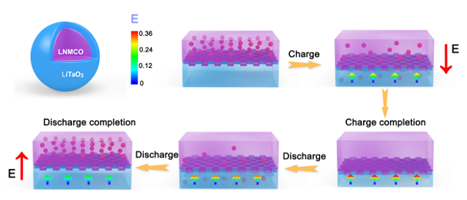Recently, Professor Bai Ying's group from the School of Physics and Electronics of our university has made new progress in the field of regulating ion transport at the interface of lithium-ion batteries, published in" Advanced Science ". Si Mengting, a graduate student of our university, is the first author of this paper, and Associate Professor Zhao Huiling and Professor Bai Ying are the co-corresponding authors.
Lithium-ion batteries have been widely used in portable digital electronic products due to their advantages such as high energy density, high output voltage, long cycle life, and low environmental pollution. They have broad applications in electric vehicles, large-scale energy storage, and aerospace prospect. However, the structural stability and ion transport characteristics of the electrode-electrolyte interface have become bottlenecks. How to design and build a stable and effective interface layer to improve the ion transport operation at the interface is a challenge in the field of lithium ion batteries.

Schematic diagram of LiTaO3 piezoelectric cladding regulating interface ion transport
In this work, Bai Ying's group used the unique pressure response characteristics of piezoelectric materials to conduct the "lattice breathing" stress during the charge and discharge of the positive electrode material to the surface piezoelectric layer, inducing the electrode-electrolyte interface in situ A periodically changing local electric field is formed, and a functional interface modification layer that "actively participates and actively acts" compared to traditional inert surface modification materials is obtained, which effectively stabilizes the interface structure and effectively promotes the interface ion transport. This research work provides new insight to design and optimize the solid-liquid interface of lithium ion batteries (DOI: 10.1002 / advs.201902538).
Advanced Science is a Wiley multi-disciplinary journal covering materials science, physics and chemistry, medical and life sciences, and basic and applied sciences in engineering. The annual publication volume is less than 400 and the impact factor (2019 journal citation report) is 15.804.
Website link:https://doi.org/10.1002/advs.201902538
In addition, Bai Ying's group recently proposed doping solid electrolyte metal cations onto the active electrode surface to improve the compatibility between the electrode-electrolyte solid-solid interface and optimize the ion transport at the interface Behavior, providing a new solution for the development of all-solid-state secondary batteries (Nanoscale, 2019, 11, 8967-8977; ACS Applied Materials & Interphases, 2019, 11, 16233-16242).
Website link:https://pubs.rsc.org/en/content/articlelanding/2019/nr/c9nr01655d#!divAbstract
Website link:https://pubs.acs.org/doi/10.1021/acsami.9b02996